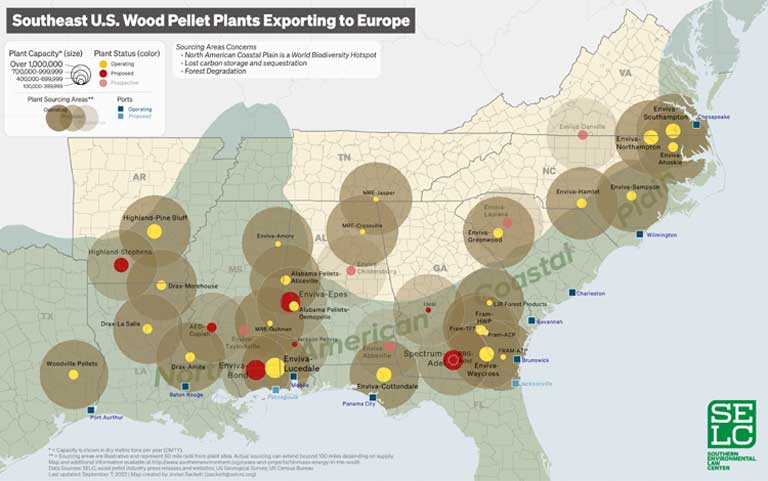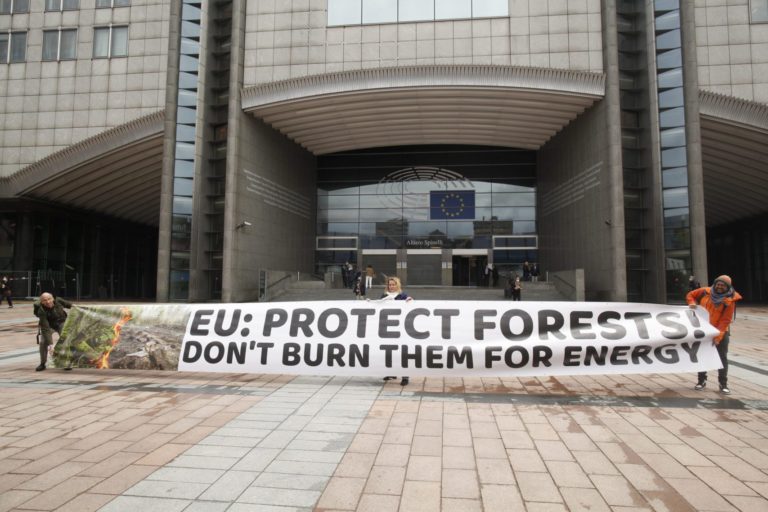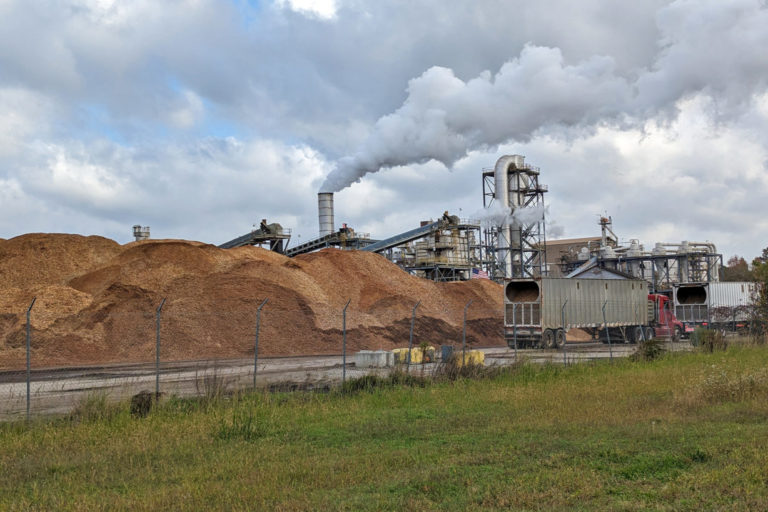- The EU hopes to finalize its revised Renewable Energy Directive (RED) soon, even as forest advocates urge last minute changes to significantly cut the use of woody biomass for energy and make deep reductions in EU subsidies to the wood pellet industry.
- Forest advocates are citing a new commentary published in Nature that argues that the EU’s continued expansive commitment to burning forest biomass for energy will endanger forests in the EU, the U.S. and elsewhere — resulting in a major loss in global carbon storage and biodiversity.
- Changing RED to meet forest advocate recommendations seems unlikely at this point, with some policymakers arguing that woody biomass use is the only way the EU can achieve its 2030 coal reduction target. The woody biomass industry is pressing for sustained biomass use and for continued subsidies.
- Russia’s threat of reducing or cutting off its supply of natural gas to the EU this winter is also at issue. In the EU today, 60% of energy classified as renewable comes from burning biomass. If RED is approved as drafted, bioenergy use is projected to double between 2015 and 2050, according to the just published Nature commentary.
As European Union policymakers move to finalize revisions to the Renewable Energy Directive in coming weeks, forest advocates continue calling for tougher regulations that would reduce the amount of woody biomass for energy used and slash the billions in EU subsidies that encourage the transformation of native forests into wood pellets for burning.
The advocates’ arguments have been given a boost by a recent commentary published in Nature arguing that the EU’s overarching goal of reducing emissions by 55% by 2030 is being thwarted by land-use policies that encourage the diversion of vast quantities of European cropland and forests to bioenergy, thus undermining habitat conservation and carbon storage in both Europe and overseas.
Commentary co-author Tim Searchinger, an expert on bioenergy policy at Princeton University, wrote that the EU’s “own modeling predicts that yearly use of bioenergy will more than double between 2015 and 2050, from 152 million to 336 million tonnes of oil equivalent. That requires a quantity of biomass each year that is twice Europe’s present annual wood harvest.”
The majority of that wood for bioenergy now comes from forests being cut in Eastern Europe and Scandinavia, with the rest coming from U.S. Southeast forestlands. As the climate crisis escalates carbon storage capacity in these forests continues to decline as demand for wood pellets to replace coal keeps rising globally. Forest cover is declining worldwide at a far faster rate than forest expansion and new tree plantation plantings.
Searchinger argues that even if the EU ultimately decides to reduce the amount of bioenergy produced from wood on the continent, but doesn’t limit EU demand, deforestation for pellet production will just increase somewhere else — likely in the U.S. — with no net climate benefits.
Europe, with its population in decline, Searchinger argues, is in a good position to consider policies that shrink its land-use footprint for both agriculture and bioenergy, thus promoting increased carbon storage and biodiversity in the EU as other parts of the world wrestle with population growth and increased land-use demands, he told Mongabay.

‘The simplest solution’
In the EU today, 60% of energy classified as renewable comes from burning woody biomass instead of coal. EU policy, which designates biomass as carbon neutral, enables countries to not count biomass emissions at the smokestack, resulting in dubious carbon accounting. A host of studies have found that burning biomass is more carbon intensive than coal per unit of energy.
“The simplest solution is for the EU to stop treating biomass from energy crops and wood harvests as carbon neutral,” Searchinger wrote, adding that “The European Parliament adopted an amendment [in September] to freeze the quantity of woody biomass that counts as ‘low carbon’ at each EU country’s 2020 level of use.”
If that rule within the Renewable Energy Directive (RED) survives the current trilogue — negotiations between the European Parliament, Council and Commission — “it could limit the damage” to standing forests, Searchinger said.
Kenneth Richter, a bioenergy policy officer for Birdlife Europe in Germany, applauded Searchinger’s findings and recommendations.
“The EU political institutions that are currently negotiating must take note of this research,” Richter told Mongabay. “The outcome of negotiations should at least result in a capping, followed by a phasedown of wood-based bioenergy proposed by the EU Parliament.”

Encouraged and skeptical
Forest advocates like Richter were both encouraged and skeptical in September of the first-ever regulations proposed by the EU Parliament on woody biomass under RED. Limits on old-growth logging were proposed then, as was a cessation of subsidies for whole trees harvested for wood pellets.
But enforcement mechanisms for such regulations remain vague. Also, capping pellet burning to 2017-2022 levels as RED currently proposes, would codify the years of peak production rather than encouraging reductions, and keep wood harvests high.
Dutch forest advocates Fenna Swart and Maarten Vischers continue to lobby the EU trilogue for tighter regulations and fewer loopholes. They recommend a cap for biomass burning at 2017 levels only, which would lead to an immediate reduction. They also propose excluding all primary and old-growth forests from biomass harvests; and shifting billions in biomass subsidies to zero-carbon renewables such as geothermal, wind and solar.
“It is best to immediately stop subsidies and incentives for the combustion of all… primary and second woody biomass,” Swart and Vischers told Mongabay. “EU policymakers must respond with RED revisions that protect the land sector and forests.”
Whether these protections will be incorporated into RED is in doubt. The view of The Netherlands’ Frans Timmermans, first vice president of the European Commission and extremely influential on matters of environmental policy, seems typical of most EU policymakers. He remains committed to forest biomass for energy because, as he has claimed, the burning of wood is the only way the EU will meet its mandate to phase out coal by 2030.

The Russian complication
Biomass industry advocates are aggressively conducting their own RED lobbying, as they lock in long-term contracts to supply wood pellets to the United Kingdom, EU and Asia for the next 10 years. In September, the industry appeared to shrug off the proposed RED regulations on biomass and focused instead on the continued definition by the EU of woody biomass as a renewable energy source, on par with wind and solar.
At a biomass industry conference on Nov. 29, Thomas Meth, the new CEO of U.S.-based Enviva, the world’s largest producer of wood pellets, told his colleagues to not back down: “When you think about the discussions in Europe and the European Parliament, if we don’t make our case [for biomass burning] — particularly the noise of ideology versus national security driven by energy — the case will be made for us.”
Meth zeroed in on a critical factor immediately in the industry’s favor: Russia using natural gas as a weapon against Europe this winter in its war with Ukraine. Wood pellets, he stressed, “can more quickly reduce [the EU’s] dependence on Russian gas.”
But complicating matters is the tarnishing this week of Enviva’s green credentials by a company whistleblower who told Mongabay in exclusive interviews that the wood pellet manufacturer’s claim of “being good for the planet [is] all nonsense,” and that the firm uses whole trees to make wood pellets, not wood waste.

Outside the RED negotiation, and in an apparent effort to stop non-biomass related deforestation, members of the EU Parliament, according to a release, “reached a preliminary deal with EU governments on a new law on deforestation-free products that will [require] companies to verify and issue a so-called ‘due diligence’ statement that goods placed on the EU market have not led to deforestation and forest degradation anywhere in the world after December 31, 2020.” Interestingly, wood pellets are not on the EU list of commodities linked to deforestation and degradation.
Regardless, which side of the RED debate these intense lobbying efforts will benefit remains unclear. Forest advocates appear to be slowly getting through to policymakers with their arguments and evidence, with public opposition to biomass for energy increasing across the EU. However, the amount of wood pellets burned annually across the continent continues growing as does industry revenue.
Don’t expect any surprises [regarding changes to the RED draft], a spokesperson for a German member of the Parliament, who declined to be named, told Mongabay. As negotiations continue, the spokesperson said, positions that go beyond the Parliament’s recommendations in September “are not likely to be discussed.”
Banner image: Wood pellets to be burned to make energy. Photo credit: marcus5spot on VisualHunt.
Justin Catanoso, a regular contributor to Mongabay, is a professor of journalism at Wake Forest University. Follow him on Twitter @jcatanoso.
FEEDBACK: Use this form to send a message to the author of this post. If you want to post a public comment, you can do that at the bottom of the page.
This story first appeared on Mongabay
South Africa Today – Environment
This article is licensed under a Creative Commons Attribution-NoDerivatives 4.0 International License.
You may republish this article, so long as you credit the authors and Mongabay, and do not change the text. Please include a link back to the original article.












